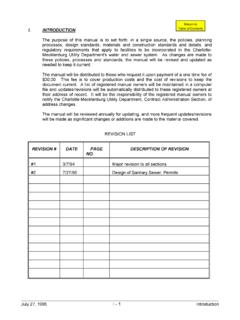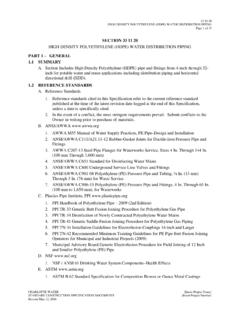Transcription of CHAPTER 3 OPEN CHANNEL HYDRAULICS - Charlotte, North …
1 CHARLOTTE-MECKLENBURG STORM WATER DESIGN MANUAL CHAPTER 3 OPEN CHANNEL HYDRAULICS Overview .. 3- 1 introduction .. 3-1 CHANNEL Linings .. 3-1 Vegetative .. 3-1 Flexible .. 3-1 3-1 Design Criteria .. 3-2 General Criteria .. 3-2 Return Period .. 3-2 100+1 Flood Analysis .. 3-2 Velocity Limitations .. 3-3 Manning s n Values .. 3-3 General Considerations .. 3-3 Selection .. 3-3 Manning s n Values .. 3-5 Open CHANNEL Design .. 3-6 CHARLOTTE-MECKLENBURG STORM WATER DESIGN MANUAL Overview .. 3-6 Design of Stable Channels .. 3-6 Permissible Velocity .. 3-7 Selecting Permanent CHANNEL Lining .. 3-7 Tractive Force .. 3-8 Design Procedure Using Permissible Velocity and Tractive Force Procedures.
2 3-9 Example Problem .. 3-13 Riprap 3-16 Assumptions .. 3-16 Procedure for Riprap CHANNEL Design .. 3-17 Approximate Flood Limits .. 3-25 introduction .. 3-25 Floodline Restrictions .. 3-25 Appendix 3A Hydraulic Terms .. 3-26 Energy of Flow .. 3-26 Steady and Unsteady .. 3-27 Uniform and Non-Uniform Flow .. 3-27 Froude Number .. 3-27 Critical Flow .. 3-27 Subcritical Flow .. 3-28 Supercritical Flow .. 3-28 Appendix 3B Best Hydraulic Section .. 3-29 introduction .. 3-29 Equations .. 3-29 Appendix 3C Open CHANNEL Flow Calculations .. 3-31 Design Charts .. 3-31 CHARLOTTE-MECKLENBURG STORM WATER DESIGN MANUAL Manning s Evaluation .. 3-31 Geometric Relationships.
3 3-31 Normal Depth Solutions .. 3-32 Appendix 3D Critical Flow Calculations .. 3-34 Background .. 3-34 Semi-Empirical Equations .. 3-34 Froude Number .. 3-35 CHAPTER 3 OPEN CHANNEL HYDRAULICS 3-1 OVERVIEW introduction This CHAPTER emphasizes procedures for performing uniform calculations that aid in the selection or evaluation of appropriate CHANNEL linings, depths, and grades for natural or man-made channels. Allowable velocities are provided, along with procedures for evaluating CHANNEL capacity using Manning s equation. For information on roadside ditch requirements see CHAPTER 4. CHANNEL Linings The three main classifications of open CHANNEL linings are vegetative, flexible and rigid.
4 Vegetative linings include grass with mulch, sod, and lapped sod. Rock riprap is a flexible lining, while rigid linings are generally concrete. Vegetative Vegetation is the most desirable lining for an artificial CHANNEL . It stabilizes the CHANNEL body, consolidates the soil mass of the bed, inhibits erosion on the CHANNEL surface, and controls the movement of soil particles along the CHANNEL bottom. Conditions under which vegetation may not be acceptable; however, include but are not limited to: 1. Flow conditions in excess of the maximum shear stress for bare soils; 2. Standing or continuous flowing water; 3. Lack of regular maintenance necessary to prevent domination by taller vegetation; 4.
5 Lack of nutrients and inadequate topsoil; 5. Excessive shade; or 6. Excessive velocities Proper seeding, mulching, and soil preparation are required during construction to ensure establishment of a healthy stand of grass. Soil testing may be performed and the results evaluated by an agronomist to determine soil treatment requirements for pH, nitrogen, phosphorus, potassium, and other factors. In many cases, temporary erosion control measures are required to provide time for the seeding to establish a viable vegetative lining. Sodding should be staggered, to avoid continuous seams in the direction of flow. Lapped or shingle sod should be staggered and overlapped by approximately 25 percent.
6 Staked sod is usually only necessary for use on steeper slopes to prevent sliding. Flexible Rock riprap including rubble is the most common type of flexible lining. It presents a rough surface that can dissipate energy and mitigate increases in erosive velocity. These linings are usually less expensive than rigid linings and have self-healing qualities that reduce maintenance. They typically require use of filter fabric and allow the infiltration and exfiltration of water. The growth of grass and weeds through the lining may present maintenance problems. The use of flexible lining may be restricted where space is limited, since the introduction of linings with higher roughness values generally results in the need for greater CHANNEL capacity.
7 Rigid Rigid linings are generally constructed of concrete and used where smoothness offers a higher capacity for a given cross-sectional area. Higher velocities, however, create the potential for scour CHARLOTTE-MECKLENBURG STORM WATER DRAINAGE MANUAL 3-2 at CHANNEL lining transitions. A rigid lining can be damaged by flow undercutting the lining, CHANNEL headcutting, or the buildup of hydrostatic pressure behind the rigid surfaces. When properly designed, rigid linings may be appropriate where the CHANNEL width is restricted. Filter fabric may be required to prevent soil loss through pavement cracks. Under continuous base flow conditions when a vegetative lining alone would be appropriate, a small concrete pilot CHANNEL could be used to convey the continuous low flows.
8 Vegetation could then be maintained for conveying larger flows. DESIGN CRITERIA General Criteria The following criteria shall be used for open CHANNEL design: 1. CHANNEL side slopes shall be stable throughout the entire length and slope shall be no steeper than 2:1. 2. Superelevation of the water surface at horizontal curves shall be accounted for by increased freeboard. 3. A minimum freeboard of 6 must be provided in the 10-year design storm. 4. Transition from closed systems to CHANNEL sections (or between transitioning CHANNEL sections) shall be smooth and gradual, with a minimum of 5:1 taper. 5. Low flow sections shall be considered in the design of channels with large cross-sections (Q > 100 cfs).
9 Some CHANNEL designs will be required to have increased freeboard (see North Carolina Erosion and sediment Control Planning and Design Manual, Section ). Return Period Open CHANNEL drainage systems shall be designed to convey a 10-year design storm. The peak flow rate for the 100-year storm shall be computed at appropriate points within the drainage system to determine if a 100 + 1 flood study is required as described in section sediment transport requirements must be considered for conditions of flow below the design frequency. A low flow CHANNEL component within a larger CHANNEL can reduce maintenance by improving sediment transport in the CHANNEL .
10 100+1 Flood Analysis All streams in the City of Charlotte and Mecklenburg County which drain more than one square mile (640 acres) are regulated by Floodplain Ordinances, which restrict development in those flood plains. However, storm water conveyances that drain less than one square mile will also flood and require regulation as well. This regulation is known as the 100+1 flood analysis. The following criteria will be used to determine how and when the 100+1 flood analysis will be used. 1. The 100+1 analysis will be required for all portions of the drainage system which are expected to carry 50 cfs or more for the 100-year storm. CHAPTER 3 OPEN CHANNEL HYDRAULICS 3-3 2.









